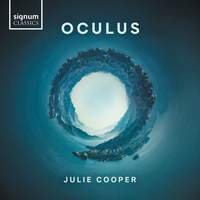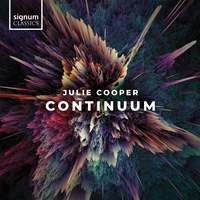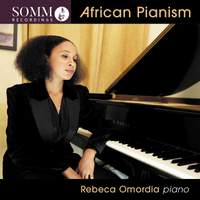Interview,
Julie Cooper on Oculus
Inevitably, though, such music is just one part of a greater whole - heightening the drama and capturing the mood, but rarely in the foreground in its own right. Cooper's first 'solo' album of standalone instrumental music, Continuum, was released in 2022 and was inspired by the collective and individual experience of the Covid lockdowns; her second, Oculus, builds on it with a varied programme of works exploring the idea of colour, from the paintings of the Italian Renaissance to the experiences of her ensemble's conductor, Jessica Cottis, with synaesthesia.
I spoke to Julie to find out more about this album, about some of the musical friendships that are woven into it, and about her advocacy for the works of underrepresented composers in the concert-hall.
Image credit: Nick Rutter
Your first album of ‘contemporary classical’ music, Continuum, was a direct response to the upheavals and privations of 2020-2021. What about Oculus - where did the inspiration come from for this album with its emphasis on colour?
I was lucky enough to have the wonderful Jessica Cottis conducting the Oculus Ensemble on both Continuum and Oculus. Whilst we were recording Continuum at Abbey Road I discovered and was fascinated by Jessica seeing extremely specific, vividly descriptive colours when conducting, triggered by the key of the music. This is through her amazing gift of synaesthesia (or chromaesthesia in terms of colour in music), a gift I sadly don’t have!
So along with the idea of an ‘oculus’ being a light to draw our eye up to the skies and the influence of the Italian Renaissance, the inspiration for the album journey and titles of tracks started to fall into place and I bombarded Jessica for a year with the colours she sees certain keys in as I was writing.
So the colour references in the album’s titles refer to the key of the track.
You hint at a kind of parallel between the Renaissance era - that background influence you mentioned - and the period of re-emergence from Covid lockdowns. Is Oculus then a kind of sequel to Continuum?
Because of the timing of when I started to think about writing Oculus I would say ‘yes’.
After the release of Continuum, written during the year of lockdowns, we were still very much coming out of the pandemic and I felt a very strong sense that we needed to reset and find a new positive way forward in our lives and the Arts, yes a bit like the Renaissance coming out of the Dark Ages, to draw our heads up.
Continuum was very much written as a musical diary in reaction to being locked down and how our senses and emotions were heightened by all happening, I certainly became much more aware of the cycle of nature around us as time had stopped still. I like to think that Oculus evolved as a beacon of light coming out of the pandemic and really wanting to find that world of colour again.
Both albums have the Oculus Ensemble at their core, formed for Continuum, an ensemble of extremely talented musicians whom have played on many recording sessions, albums and concert works of mine over the years whom I greatly admire.
Also both albums are produced by Jonathan Allen, so I have him to thank for creating the sound-worlds for them.
Can you tell us a little about your newly-forged musical friendship with the pianist Rebeca Omordia (who appears on this album playing the work Ascensio, which you wrote for her)?
Rebeca and I met through the social media frenzy of the release of our lockdown albums coinciding, Rebeca’s African Pianism and my Continuum. We immediately became friends and admirers of each other’s work with a strong desire to work together.
I had heard an earlier beautiful Vaughan Williams album of Rebeca’s duetting with Mark Bebbington, and was really mesmerised on African Pianism by how Rebeca was able to combine in her playing the sensitivity of the Vaughan Williams with the passionate, intricate rhythms of the African composers.
Through starting to rediscover the art of the Italian Renaissance, I had also recently discovered the incredible Tulip Stairs in the Queen’s House in Greenwich which had been built around 1616 by Inigo Jones inspired by his travels to Italy and the Italian Renaissance architecture. I fell in love with the tulip spiral staircase which has an oculus at the top to let light in and draw your eye upwards. This was the perfect inspiration I thought to write something for Rebeca. And so ‘Ascensio’ came to be one of the 1st tracks written on the album.
The first track, Moonglade in Jet Black, features an instrument with the intriguing name of ‘space harp’, played by Joby Burgess. What exactly is this, and what does it bring to the music?
The space harp is a little like very thin tuned tubular bell pipes but they are fixed to a frame and instead of striking them with a hammer, they are played by stroking them with fine white gloves on, producing an incredibly delicate, atmospheric high pitched pure sound.
I discovered this extraordinary percussion instrument 10 years ago at a concert in Union Chapel, London where on stage was not only Joby Burgess playing this exquisitely ethereal instrument but also a soprano with a unique ethereal purity like no other – Grace Davidson! It’s taken me all this time to find the right track to use this space harp on with Joby playing and I knew immediately when writing Moonglade in Jet Black, this would be the perfect sound that would bring light to a track set in the black of night over the ocean.
Your first major success as a composer was a prize-winning Christmas carol composed in your teens, though since then you seem to have worked mostly with orchestral or chamber textures. Who would you say have been the main influences on your own musical development?
I have always had a great love of the cinema and Film Soundtracks, my dream from a teenager was to score films. I listened to and adored pop songs with string arrangements in the mix. I have a vivid memory when I was young of the haunting evocative opening theme to the scary Roald Dahl television drama series ‘Tales of the Unexpected’ written by Ron Grainer.
I found an orchestral score combined with either a song lyric or drama on screen could move me like nothing else.
I studied music at University loving the atmospheres and orchestral colours in the scores of Vaughan Williams, Debussy, Ravel, Sibelius, Stravinsky etc. My early 20s were spent idolising and trying to transcribe the soundtracks of John Williams, Bernard Hermann, Ennio Morricone and many others. Always combined with listening to a lot of R&B, Soul and pop!
I actually started my career from University touring as a keyboard player in Theatre, then came commissions for electronic ambient scores for theatre productions, often with percussion to add colour, along with commissions for commercial music for advertising and light entertainment television programmes which tended to combine electronic with acoustic instruments depending on budgets.
In my mid-20s I received my first concert commission from Chichester Festival, ‘Seasons’, for the iconic percussionist (Dame) Evelyn Glennie at Chichester Cathedral. Based on the Vivaldi ‘The Four Seasons’ scored for an array of percussion instruments and a full stage band and chamber choir. Evelyn was an incredible inspiration to write for and opened my ears to the hugely colourful world of percussion for which I am eternally grateful to her. ‘Seasons’ went on to receive its London premiere at the Royal Albert Hall.
The BBC Radio Drama commissions followed this and were my 1st opportunity to have a budget to experiment with solely acoustic chamber ensembles and use of a ‘vocalise’ soprano in the scores to enhance drama. Discovering the voice of Grace Davidson in that concert 10 years ago has led to her being my muse inspiring so many tracks, she has a unique talent and sound that is pure joy to write for. Oculus is our third album together.
Much of your work to date has been in scoring film and television works, including nature documentaries - several of the works on Oculus evoke a sound-world that fans of wildlife programming will find pleasingly familiar. How different is that kind of composition, compared to writing as it were for the ‘concert hall’?
I think I see things very visually when writing music and am often inspired by nature, I tend to start from the same place whether scoring with screen visuals in mind or the concert platform - a very strong inspiring brief - whatever format that might be, whether set by myself from something that has inspired me or by a script or visual supplied.
Scoring for a production music album, whether for usage on wildlife documentaries, television drama or film, you know the music will be used with visuals and dialogue, so that needs to be taken into consideration when writing and scoring but the music also still needs to have the ability to enhance dramatically at times. Normally there will be various different versions supplied so a director making the programme/film has options.
Music for the concert hall usually stands alone so the music needs to capture an audience’s imagination purely through what they’re hearing, there’s also a lot more freedom with time to tell a story.
Among other things you’re an active promoter of gender parity in classical music - working with Ellie Consta’s ‘Her Ensemble’ on this album, and supporting Gabriella Di Laccio’s Donne - Women in Music foundation. How can listeners and audiences get involved and help out with this work?
I think the most important way listeners and an audience can help support this is to not settle for that long list of white male composers in the programme everytime when they go to a concert hall or look down a radio station’s schedule.
Question the Concert Hall programming the concert.
Support concerts embracing diversity and inclusion in both their choice of music and performers.
When listening to the radio and there’s an opportunity to text/phone in requests, start to listen to Women Composer playlists available on streaming sites and curated by organisations like Donne – Women in Music, discover all the wonderful music out there both current and historically that has been written/performed by women so you can request it.
Are Continuum and Oculus a sign of things to come - should we expect more albums of this kind from you in the future?
I would like to think so, if that’s where my musical journey takes me ... and the audience/listeners will have me!
Grace Davidson, Anna Hale (sopranos), Joshua Davidson (treble), Clio Gould (violin), Cara Berridge (cello), Rebeca Omordia, Julie Cooper (pianos), Eliza Marshall (flute), Joby Burgess (percussion), Camilla Pay (harp), Her Ensemble, Oculus Ensemble, Jessica Cottis, Simon Hale
Available Formats: CD, MP3, FLAC, Hi-Res FLAC
Adjoa Andoh (narrator), Grace Davidson (soprano), Elena Urioste, Clio Gould (violins), Justin Pearson (cello), Anthony Pike (clarinet), Camilla Pay (harp), Nicholas McCarthy, Julie Cooper (pianos), Oculus Ensemble, Jessica Cottis
Available Formats: CD, MP3, FLAC, Hi-Res FLAC
Mark Bebbington & Rebeca Omordia (pianos)
Available Formats: CD, MP3, FLAC, Hi-Res FLAC
Rebeca Omordia (piano)
Available Formats: CD, MP3, FLAC







